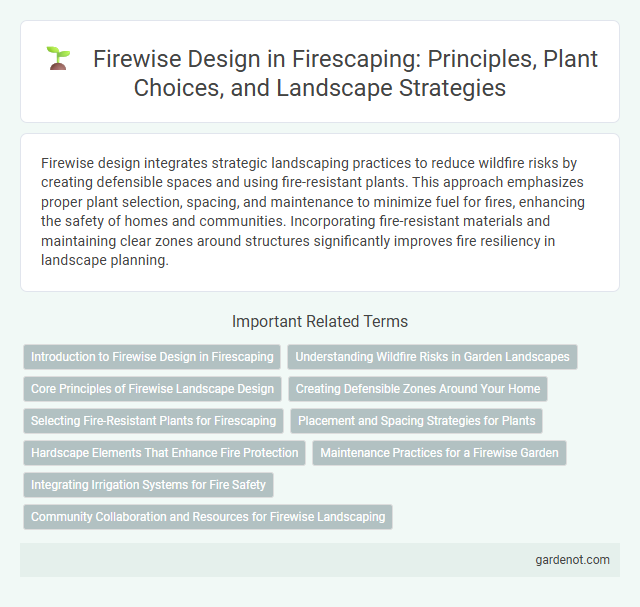Firewise design integrates strategic landscaping practices to reduce wildfire risks by creating defensible spaces and using fire-resistant plants. This approach emphasizes proper plant selection, spacing, and maintenance to minimize fuel for fires, enhancing the safety of homes and communities. Incorporating fire-resistant materials and maintaining clear zones around structures significantly improves fire resiliency in landscape planning.
Introduction to Firewise Design in Firescaping
Firewise design in firescaping integrates landscape planning principles to reduce wildfire risk by selecting fire-resistant plants and maintaining defensible space around structures. Emphasizing proper spacing, fuel breaks, and strategic placement of vegetation, this approach lowers the chance of fire spreading to homes. Understanding local fire behavior and incorporating native, drought-tolerant species enhances landscape resilience while promoting ecosystem health.
Understanding Wildfire Risks in Garden Landscapes
Firewise design emphasizes assessing wildfire risks by identifying flammable vegetation and incorporating fire-resistant plants in garden landscapes. Understanding local fire behavior and topography helps create defensible space to slow wildfire spread and protect property. Implementing strategic plant placement, proper spacing, and maintaining moisture levels enhances garden resilience against wildfire threats.
Core Principles of Firewise Landscape Design
Firewise landscape design emphasizes creating defensible space by using fire-resistant plants, maintaining proper spacing to reduce fuel continuity, and incorporating hardscape elements such as gravel or stone pathways to act as firebreaks. Vegetation management involves pruning, removing dead plant material, and selecting native species with high moisture content to minimize fire intensity. Maintaining adequate clearance around structures and designing landscapes that slow or redirect fire spread are core principles crucial for enhancing home survivability during wildfires.
Creating Defensible Zones Around Your Home
Creating defensible zones around your home involves strategically clearing vegetation and combustible materials to reduce fire risk and enhance safety. Firewise design emphasizes maintaining a minimum of 30 feet of lean, green, and well-watered landscaping closest to structures, gradually decreasing flammability in outer zones. This layered approach slows wildfire spread, providing critical time for evacuation and fire suppression efforts.
Selecting Fire-Resistant Plants for Firescaping
Selecting fire-resistant plants for Firescaping enhances landscape resilience by reducing fuel load and slowing fire spread. Plants such as succulents, lavender, and manzanita exhibit low flammability due to high moisture content and minimal volatile oils. Incorporating these species into Firewise design supports defensible space creation and promotes safety around structures in fire-prone areas.
Placement and Spacing Strategies for Plants
Firewise design emphasizes strategic placement and spacing of plants to reduce fire hazards around homes. Maintaining adequate distances between trees and shrubs, as well as ensuring they are not directly adjacent to structures, helps minimize fuel continuity and slow fire spread. Incorporating fire-resistant plant species with careful arrangement enhances defensible space and increases a property's resilience against wildfires.
Hardscape Elements That Enhance Fire Protection
Hardscape elements such as stone patios, gravel pathways, and concrete driveways create effective firebreaks by reducing combustible materials near structures. Incorporating non-flammable features like brick retaining walls and metal edging further limits the spread of wildfire embers. Proper placement of these elements around homes enhances Firewise design by minimizing fire fuel continuity and promoting safety during wildfire events.
Maintenance Practices for a Firewise Garden
Regular maintenance of a Firewise garden involves clearing dead vegetation and debris to reduce fuel for wildfires. Pruning trees and shrubs to maintain safe distances from structures enhances fire resistance. Consistent irrigation keeps plants healthy and less prone to ignition, supporting overall fire mitigation efforts.
Integrating Irrigation Systems for Fire Safety
Integrating irrigation systems into Firewise landscaping design enhances fire safety by maintaining optimal moisture levels in vegetation and soil, reducing the risk of ignition and fire spread. Automated drip irrigation and smart controllers allow precise water delivery to defensible space zones, promoting healthy plant growth without excess water use. These systems also support the strategic placement of fire-resistant plants, creating effective fuel breaks that slow wildfire advance.
Community Collaboration and Resources for Firewise Landscaping
Firewise design emphasizes community collaboration by integrating local knowledge and shared resources to enhance fire-resistant landscaping practices. Coordinated efforts between homeowners, fire departments, and local governments foster the implementation of defensible space, native fire-resistant plants, and strategic vegetation management. Access to Firewise resources, including educational materials, workshops, and grants, supports sustainable community-wide wildfire mitigation and resilience.
Firewise design Infographic

 gardenot.com
gardenot.com